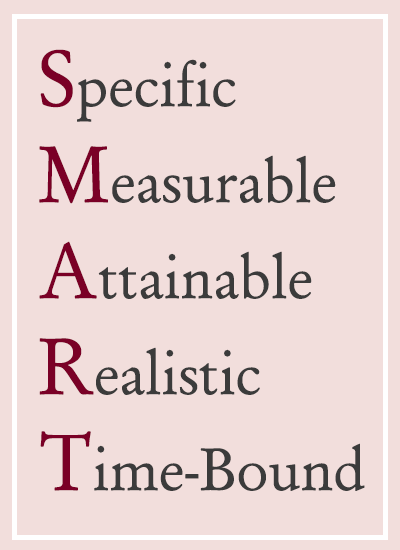Here come the New Year’s resolutions!  Maybe you already have a few resolutions in mind, or perhaps you’re scraping them all together this year.
Maybe you already have a few resolutions in mind, or perhaps you’re scraping them all together this year.
As one year comes to an end and another begins, we often become reflective of our accomplishments and begin looking forward to the New Year. New Year’s resolutions, for many of us, serve as a discomforting reminder of past objectives that we had every intention of resolving, but unfortunately never met. After experiencing disappointment, some choose to resolve to have no resolutions at all.
The idea of a New Year’s resolutions may be very daunting and intimidating thought. For some reason, just the thought of setting resolutions seems to carry more weight than other goals we may set for ourselves at any other time of the year. We want to begin the New Year from a fresh and renewed place, and perhaps the thought of being unsuccessful at accomplishing our “New Year, New Me” goals tarnishes the sparkle of the New Year.
For those of you considering giving resolutions one more shot, here are some suggestions for you to consider before setting your New Year goals. You’ll be much more likely to be successful if you follow the SMART acronym for goal setting.”
Specific
We can often name general goals we have for ourselves, but unless these goals are clear and specific we are less likely to achieve them. The best way to make a goal more specific is to think about the five “W” questions. When considering your New Year’s resolutions, ask yourself these questions to help you specify what you would like to achieve:
What: What do I want to accomplish?
Why: Specific reasons, purpose or benefits of accomplishing the goal
Who: Who is involved? And who is not involved?
Where: Identify a location
Which: Identify requirements and constraints
Let’s Try an Example
For example, Elaine has decided that one of her New Year’s resolutions is to exercise more in the New Year. To make this goal more specific, she defined her goal by asking herself the previously stated questions.
What: Elaine would like to exercise three times per week for 30 minutes at a time.
Why: Elaine would like to have more stamina when completing her daily errands and taking care of her children, potentially prevent future health issues, and feel healthier overall.
Who: Elaine has enlisted her good friend Sarah to join her for weekly aerobics classes at the local community centre, and her immediate family to join her on after dinner walks.
Where: Elaine will enroll in a weekly aerobics class at her local community centre and knows of a walking path a few blocks from her home that she and her family will enjoy walking on.
Which: The requirements of this goal are that she purchase a new pair of athletic shoes, enroll in the aerobics class at the community centre, and arrange for child care on the nights both she and her husband are out of the house, so she can make it to the aerobics class.
Measurable
Having a measurable goal ensures that you know concretely what you’re aiming for and what achieving your goal will look like. Making a goal measurable usually involves quantifying your goal. This can mean setting a specific timeline for yourself, or a certain number to aspire to (e.g. cutting down from 15 cigarettes per day to 10, and eventually to zero cigarettes smoked in a day). Some goals, such as improving your relationship with your partner, are more difficult to measure. Think of what having a better relationship would look like, and what it would entail. For some, if they had a better relationship they would spend more quality time with their partner. A measurable component can be added to this by aiming to have one date night per week with your partner or to spend one hour together each evening before going to bed.
In Elaine’s case, setting the goal to exercise three times per week for 30 minutes each time ensures that her New Year’s resolution is measurable.

Attainable
When coming up with your New Year’s resolutions, be sure that they are attainable. Elaine may have decided that she was going to run a marathon at the end of February, after being quite sedentary for several years. This would be a very difficult and unachievable goal for her to reach. Instead, focus on smaller short-term goals that will bring you closer to achieving your overall long-term goal. Once she has reached her attainable goal of exercising three times per week for 30 minutes at a time, Elaine may choose to revise her goal for something that is now attainable from her new fitness level.
Remember to consider any contributing factors that may influence how attainable your goal is.
For example, Elaine knows that she does not like walking in the cold very much, so this may influence her chances of walking after dinner with her family. With this in mind, she can modify her goal to ensure it is more attainable, such as making sure she is dressed very warmly before beginning the walk, or even walking on the indoor track with the family or engaging in a different indoor physical activity with the family until the weather is warmer.
Ensuring your goals are attainable will make it possible for you to stick to your New Year’s resolutions, instead of letting it go once you realize that the goal itself is just not attainable. By having an attainable goal you will be setting yourself up for greater success. This will allow you to predict any roadblocks that may come your way and prepare to make adjustments to your goals as necessary.

Realistic
Making sure your goal is realistic is an extension of having an attainable goal. This involves taking a more in-depth look at your own motivations to achieve your goal and any issues that may arise to prevent you from reaching your goal.
For example, Elaine dislikes running. She has tried to run as her chosen form of exercise in the past, but finds it unenjoyable and gives up her routine quickly. To make sure her goal is realistic, Elaine should not expect herself to run as a form of exercise to achieve her goal. She also knows that spending time with her husband is a major priority for her. Instead, Elaine decides that doing activities that she can enjoy with her husband, such as walking in the evening, would be the most realistic exercise option for her.
Ask yourself, “Will I really stick with this goal?” and “How motivated am I to achieve my New Year’s resolution?” The answers to these questions will tell you a lot about how realistic your goal is.
Time-Bound
The last component of setting a SMART New Year’s resolutions for yourself is to be sure that it is time-bound. Setting a deadline for yourself to achieve your goals will provide you with motivation and give you something to look forward to. Remember to include a realistic time goal for yourself, so that it is attainable. New Year’s resolutions should include both short-term and long-term goals, so they can be broken-down into smaller, less intimidating goals.
To start, Elaine decides that she would like to be exercising three times per week by the end of February. This allows her several weeks to achieve this goal. She may only exercise once or twice a week in the beginning as she improves her fitness. Eventually, once she is exercising three times per week she may modify her goal to include another time-bound short term goal by the end of the next month.
A time-bound component can be added externally as well to improve chances of goal achievement. Someone who does enjoy running may choose to sign-up for a race, so they have a specific date to work towards.
[themify_quote]Take each day as it comes, and start each day fresh[/themify_quote]
Your Best New Year’s Resolutions
When considering your New Year’s resolutions, remember to not judge yourself too harshly if you do not achieve your goals as quickly, or exactly how you originally would have liked. Making a change in your life can be difficult, as we all prefer habit to the unknown. By being flexible when setting goals you’ll feel less disappointment. You’ll be better able to re-evaluate and adjust your goals as challenges arise. Flexibility also increases the likelihood that you will continue to work towards some improvement in your life, instead of giving up on your resolutions all together.
Lastly, consider what has worked well for you in the past, and that has created challenges for you. With this in mind, you can tailor your goals to include what has led you to be successful in the past and modify your goal to not include what has been challenging.
As we begin a New Year, consider the year as a blank slate. Here’s your chance to make any changes you desire. Take each day as it comes, and start each day fresh.
Best wishes for the New Year, and good luck with all your SMART New Year’s resolutions!
~ Meredith of Parallel Wellness
[themify_button style=”gray” link=”http://”]Book an Appointment[/themify_button]
Hey there!!
I'm Meredith MacKenzie, the founder of Parallel Wellness and a Registered Clinical Counsellor. Simply put, I love to talk about psychology, emotions and all the things that make us human. My goal for this blog is to share information, resources and a fresh perspective on what brings clients to our practice.

